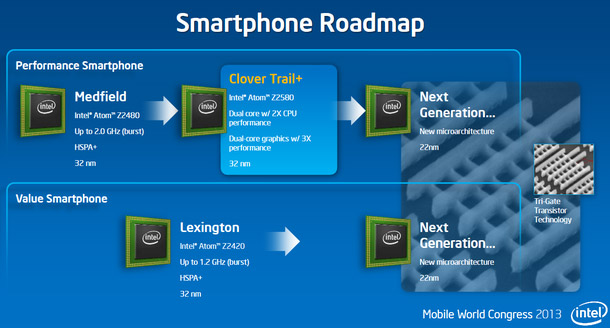Intel Clover Trail+, Advancing Atom In Mobile
Introducing Clover Trail+
 When we covered Intel’s first significant foray into the smartphone arena, early in January 2012, there was little doubt in our minds that the company had set its sights on the mobile market with a plan and roadmap for execution. Though Medfield and Lexington, now known as the Atom Z2460 SoC, and its lower cost sibling Atom Z2420, looked solid enough on paper, we expected Intel would have an uphill battle versus already well-established players like Qualcomm, Samsung, NVIDIA and the like. As it turned out, Medfield and Lexington Atom SoCs never really made it to smartphones marketed in the US, but they did gain some traction in about 10 design wins for Intel, primarily in emerging markets, Latin America, APAC and the UK. Regardless, market penetration on a more global scale just wasn’t what we assume Intel had hoped for.
When we covered Intel’s first significant foray into the smartphone arena, early in January 2012, there was little doubt in our minds that the company had set its sights on the mobile market with a plan and roadmap for execution. Though Medfield and Lexington, now known as the Atom Z2460 SoC, and its lower cost sibling Atom Z2420, looked solid enough on paper, we expected Intel would have an uphill battle versus already well-established players like Qualcomm, Samsung, NVIDIA and the like. As it turned out, Medfield and Lexington Atom SoCs never really made it to smartphones marketed in the US, but they did gain some traction in about 10 design wins for Intel, primarily in emerging markets, Latin America, APAC and the UK. Regardless, market penetration on a more global scale just wasn’t what we assume Intel had hoped for.Today, however, Intel is keeping on track for execution of their roadmap plan in the mobile space, with the release of their follow-on to Medfield, code-named Clover Trail+. Clover Trail, as you’ll remember, is powering many a Windows 8 tablet these days. Intel's latest Atom-based SoC is a more natural fit here, with the intrinsic advantages of being able to run full X86 compatible software on a tablet or convertible device, while still offering strong battery life and performance. That said, Clover Trail+, Intel’s new performance and feature-optimized version of Clover Trail for the smartphone and tablet market, has that same long row to hoe versus incumbents, at least in the highly competitive handset arena.

What’s more than interesting this time around is that Clover Trail+ seems to really have the chops (at least on paper) to keep pace with, and even exceed, certain performance characteristics of current, best-of-class ARM-based architectures that have been so dominant in smartphone designs thus far. And on the power consumption front, Intel is claiming their long-beloved “HUGI” (Hurry-Up and Get Idle) approach to clock gating will afford them a platform power advantage like no other smartphone architecture on the market currently. A tall order. Big claims. Is Intel just getting warmed up? Let’s take a look.

Clover Trail+ is another 32nm design for Intel, though their next generation Bay Trail architecture will migrate to 22nm. Bay Trail will be the first quad-core Atom design, offering twice the compute performance as Clover Trail and should arrive in time for the 2013 holiday shopping season, so we are told. Intel is already claiming good traction with major OEM partners for Bay Trail tablet designs as well. But I digress, what is immediately obvious with the Clover Trail+ platform reference design specification, versus Intel's previous generation Medfield architecture, is that Intel has beefed up almost every major functional block. Let's dive in a little deeper...
|

Clover Trail+ is another 32nm design for Intel, though their next generation Bay Trail architecture will migrate to 22nm. Bay Trail will be the first quad-core Atom design, offering twice the compute performance as Clover Trail and should arrive in time for the 2013 holiday shopping season, so we are told. Intel is already claiming good traction with major OEM partners for Bay Trail tablet designs as well. But I digress, what is immediately obvious with the Clover Trail+ platform reference design specification, versus Intel's previous generation Medfield architecture, is that Intel has beefed up almost every major functional block. Let's dive in a little deeper...







